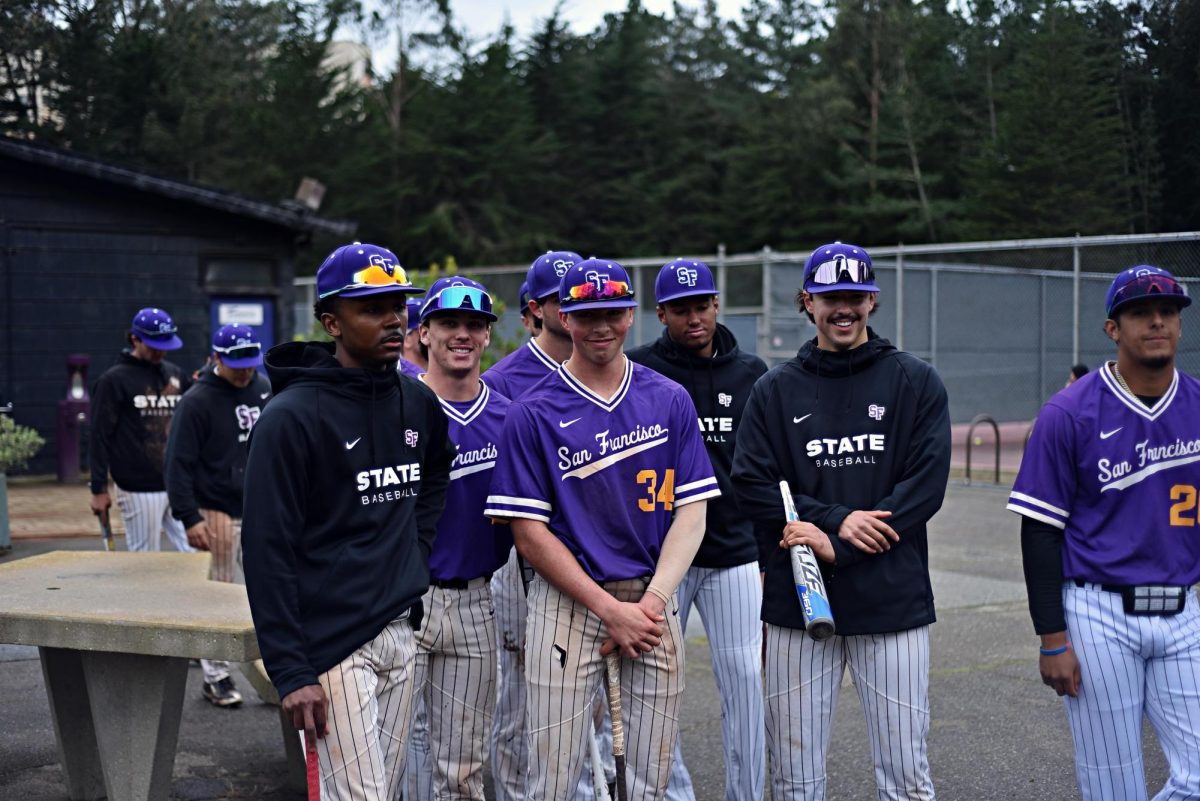San Francisco’s investor-owned utility imposed preemptive power outages on 738,000 premises in Northern California last week to prevent its equipment from sparking wildfires amid forecasts of strong winds and dry weather.
Pacific Gas and Electric executed a series of phased blackouts from late Wednesday night to early Saturday evening, 10 months after declaring bankruptcy while owing money to victims of wildfires that were sparked by its equipment.

David Mamaril Horowitz / Golden Gate Xpress)
The cautious choice, resulting in the most expansive planned power outage in California history, prompted a hue and cry that the utility acted preemptively to avoid legal damages.
PG&E CEO Bill Johnson denied that narrative at a press conference last week.
“These outages were intended solely — solely — to keep our community safe from wildfires,” he stressed.
An electrical wire creates an electrical arc and spark when struck by vegetation, Johnson explained. About 25,200 miles of the utility’s electrical wires pass through wildfire-prone areas, according to the company’s Wildfire Safety Plan.
That interaction between vegetation and power lines — combined with low humidity and strong dry winds caused by California’s recent drought — raises the chance that a spark will generate a wildfire, PG&E senior meteorologist Evan Duffy said.
“We faced a choice here between hardship on everyone or safety, and we chose safety,” Johnson summed up.
Gov. Gavin Newsom strongly disagreed, stating that the blackouts resulted from decades of neglect, greed and mismanagement by PG&E.
“They chose not to modernize their (electrical) grid over the course of many, many years. It led to their own demise. It led to their own bankruptcy,” Newsom said.
The governor rattled off some consequences of the two-day blackout: students staying home from school; parents unable bathe their children; people unable to enter their own garages; some left without water or medical supplies.
“This can’t, respectfully, be the new normal,” Newsom said.
Although PG&E isn’t charging customers for electricity during the outages, it has refused to reimburse them for costs they’ve incurred — an estimated $2.5 billion in total, according to Michael Wara, director of the Stanford Woods Institute energy and climate program.
For Petaluma resident Tom Graham, who lost power late Tuesday night, the outages led to his food poisoning. A summertime Camp Maher naturalist accustomed to backpacking in wilderness areas, Graham found himself better prepared than most, skilled and stocked with first aid kits, flashlights, batteries and 25 gallons of water.
Even for him, the outages posed an enormous inconvenience.
He said the threat of a fire forced him to prepare for immediate evacuation. It took three or four gas stations to find one with gas. Stores ran out of ice.
Graham eventually tried food from the freezer that appeared safe to eat. He called a hospital Thursday morning due to food poisoning.
The former SF State journalism professor, now 71, felt lucky this didn’t exact a greater toll given his age.
“It was sobering,” he said.
Restoration
For the vast majority of affected customers, the blackout ended within 48 hours.
PG&E deployed more than 6,300 personnel to inspect, repair and restore its power lines once the winds had passed, according to a release by the utility. They reported inspecting all 25,200 miles of lines in high-risk wildfire areas before turning the power back on.
By the end of the blackouts, PG&E had succeeded in avoiding the creation of wildfires. Meanwhile, PG&E discovered at least 50 incidents of damage to its equipment from winds and vegetation during the high-risk outage period, with 100 other locations suspected to be affected.
Johnson said those incidents led him to believe that PG&E’s equipment would have created wildfires had the company not imposed the blackouts.
But he admitted that the company failed in at least one regard: communications.
Miscommunication
Despite doubling down on its website Monday, PG&E experienced seven to eight times its normal web traffic during the outages. The webpage providing live outage data stopped working, and customers became unable to access the locations and times of the planned blackouts, according to the utility’s Chief Customer Officer Laurie Giammona.
The utility commissioned a second, more robust website to map the blackouts Wednesday. It too crashed due to the influx of visitors, but it eventually worked.
Meanwhile, some affected received zero notifications altogether. They were forced to rely on news, social media and word-of-mouth for information.
“They haven’t contacted us,” SF State junior Jannel Lakes said Wednesday.
Lakes lives in an isolated country area of Oakland with little outside light at night. Her home has been broken into before, she said, and better communication could have allowed her to take adequate precautions against burglars.
“It’s going to be pitch black,” she said. “So we want to be prepared.”
SF State senior Chris Esquivel said people in his area seemed panicked, as if they didn’t know what to do.
“Most of the information that I got was from social media,” Esquivel said.
PG&E provided around-the-clock customer service over the phone with a wait time averaging 30 seconds, Giammona said. The utility also opened 33 customer resource centers across affected counties to provide water, air conditioning, restrooms and charging services.
For many, it wasn’t enough.
SF State graduate student Pedro Ramos, an El Grenada resident, woke up to an outage of 5 a.m., five miles from the nearest PG&E center.
Neither his shower nor the toilet were functioning. But he was lucky to have a public bathroom located two city blocks away.
“Not everyone has that,” he said.
Status
Planned outages were a key part PG&E’s Wildfire Safety Plan, published earlier this year to detail the steps being taken to prevent its own equipment from generating wildfires.
The utility is on track to harden 150 miles of its power lines in high-risk areas, and manage vegetation for 2,450 miles of lines, by the end of this year.
PG&E is also attempting to conduct more inspections of its distribution poles, transmission structures and substations; septuple its nine camera stations; and double its 200 weather stations this year.
Sumeet Singh, vice president of PG&E’s Community Wildfire Safety Program, said he anticipates similar shutdowns until such steps are completed.
Future outlook
Due to the unreliable nature of weather forecasts, some of the blackouts, conducted across 34 California counties, appeared unnecessary.
In de-energized Petaluma, for example, the wind forecasts proved inaccurate.
“If … these predicted storms or wind occurrences are not materializing, people are going to be pissed off, and probably are going to be suing them for damages,” Graham said.
Moving forward, Johnson said, his company will improve communications, and upgraded weather prediction technology will more precisely and accurately narrow the scope of planned outages.
But for the governor, the issue wasn’t one to be justified.
“What has occurred in the last 48 hours is unacceptable,” he said at the Thursday conference.












